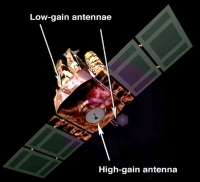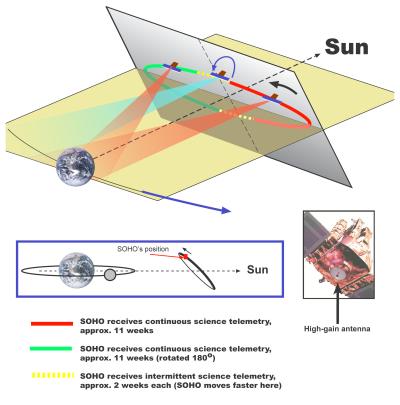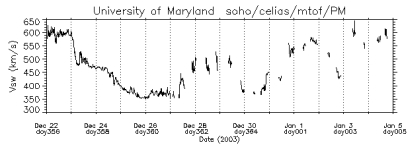SOHO Keyhole Operations
9 January 2004
From 26 December 2003 to 7 January 2004 the SOHO spacecraft went through a period known as a "Keyhole". For SOHO, now into its ninth year of operations, this is a relatively new event, and a direct result of the difficulties experienced with the High Gain Antenna (HGA) during the summer of 2003.The term "keyhole", in antenna terminology, stems from a characteristic feature of aerial navigation maps showing the coverage of, for example, a radar antenna: A circular area near the antenna is shaded due to too-short range. In addition, any obstructions (hilltops, buildings) near the antenna will cause wedges to be shaded due to lack of coverage. Taken together, the appearance of the shaded area is often that of a keyhole. The term has since been generalised to refer to any area not covered by an antenna.
What does this have to do with SOHO?
In order to get a good downlink signal, SOHO's High Gain Antenna (HGA) needs to be pointed correctly as the spacecraft traverses its highly elliptical orbit around the L1 Lagrangian point, some 1.5 million kilometres sunward of the Earth. In early May 2003, the HGA started showing signs of trouble. Its East-West pointing mechanism started missing steps, eventually triggering an on-board protective action that reconfigured the spacecraft to use its omnidirectional Low Gain Antenna. This configuration, which gives a much weaker signal at Earth, was only meant to transmit low rate data, sufficient for health monitoring and engineering but containing no science data.
 |
|
SOHO Antenna |
Since the HGA was not far off the intended pointing, high rate science telemetry could soon be restored, but a long period of troubleshooting and testing started, while the antenna pointing mechanism performance seemed to degrade. In the end, it was concluded that an undetermined mechanical problem was indeed the cause of the problems, and the antenna appeared to be stuck. However, it could still be moved using the primary and backup drive motors at the same time, doubling the torque. The problem is, nobody could say how long that would last! So, a strategic decision was made to park the antenna at the "sweet spot", which maximises the time during one half-orbit when the signal is strong enough for normal use. By turning the spacecraft up-side-down during the other half of the orbit, the coverage is doubled!
But when SOHO is in the "middle" parts of its orbit, there is no way it can point at the Sun while also pointing its HGA towards Earth. SOHO has "keyhole periods", occurring twice per orbit. Each orbit around L1 takes about half a year, so keyholes affect SOHO operations roughly every 3 months. In late June, as the first keyhole period approached, instruments prepared to shut down in various safe modes for a two-week period with only low rate telemetry.
 |
|
Schematic Diagram of the SOHO Orbit |
However, a number of discoveries about the spacecraft's and the Deep Space Network (DSN) stations' capabilities were made: Using larger 34-meter stations with better receivers instead of the standard 26-meter stations, SOHO could keep beaming high rate data through the HGA for a few days extra on each side of the keyhole. When the HGA finally had to be abandoned for the LGA, it turned out that 34-meter stations could actually pick up medium rate telemetry, not just low rate telemetry.
During normal operations, SOHO always sends high rate telemetry to Earth when in contact with a ground station. While SOHO is not in contact, data from all experiments is recorded on board at what is called medium rate. The recorder is dumped at 3 times the recording speed using the extra capacity of the high rate signal. When the medium rate recording has been secured, the extra capacity is used by the MDI instrument to send higher resolution magnetograms, Dopplergrams and white light images, which do not fit in the medium rate signal.
So while the medium rate telemetry through 34-meter stations was very good news, it still meant there would be gaps whenever SOHO was not in contact. With no capacity to dump the recorders, the total capacity of 16 hours would fill up quickly.
But DSN also has 70-meter stations - and they could in fact lock onto the high rate signal while using the LGA. We were back in business! With enough support from 70-meter stations, SOHO could have lost the HGA entirely and continued as before.
But the larger DSN stations do not stand in line at your service all the time! Although SOHO's second keyhole (September-October 2003) had so many 70-meter passes lined up that the data loss was negligible, this was highly unusual. With the many Mars missions and the Stardust competing in a different league when it comes to priority on the big dishes, SOHO has had to do with almost no 70-meter stations during the winter keyhole.
Although the amount of observing time lost is not all that great, considering the length of the mission, it matters a lot to a few instruments: MDI, GOLF and VIRGO have long-term helioseismology programs that are severely affected by gaps in the data. VIRGO also has important calibrations of its Total Solar Irradiance observations 3 times every day. These are being secured by stretching the 16-hour recording capacity to its maximum, recording those calibrations that are not captured by real time contacts. Other instruments that typically analyse their data in time-series are also affected, of course.
As a good illustration of the data coverage, the CELIAS/MTOF Proton Monitor tracks the solar wind at L1. A plot covering most of the winter keyhole (and a few days prior for comparison) is shown below:
 |
Additional Operational Benefits
Over time, many types of CCDs (Charge-Coupled Devices) used to detect EUV radiation are degraded by contamination of heavy ions from cosmic/solar particle radiation (interfering with the doping of the chip), deposits and polymerisation of deposits on the surface and, finally, trapped charges (again interfering with the doping of the substrate). These forms of degradation reduce the sensitivity of the detector. Fortunately, by heating the CCD over an extended time period, some of these effects can be reduced. Heating the CCD to improve its performance is called "baking out" the CCD. The CCDs on the EIT would be unable to do "business as usual" during keyholes, so bakeouts are now scheduled for periods where data loss is inevitable.
Table of future keyhole periods (estimated)
| High rate on 26m ends |
High rate on 34m ends |
High rate on 34m resumes |
High rate on 26m resumes |
| 2004/03/15 | 2004/03/20 | 2004/04/02 | 2004/04/07 |
| 2004/06/16 | 2004/06/19 | 2004/06/29 | 2004/07/03 |
| 2004/09/12 | 2004/09/17 | 2004/10/01 | 2004/10/05 |
| 2004/12/13 | 2004/12/16 | 2004/12/25 | 2004/12/29 |
| 2005/03/06 | 2005/03/10 | 2005/03/24 | 2005/03/28 |
| 2005/06/06 | 2005/06/10 | 2005/06/20 | 2005/06/23 |
| 2005/09/02 | 2005/09/07 | 2005/09/21 | 2005/09/26 |
| 2005/12/04 | 2005/12/07 | 2005/12/16 | 2005/12/20 |
| 2006/02/25 | 2006/03/01 | 2006/03/15 | 2006/03/19 |
| 2006/05/28 | 2006/05/31 | 2006/06/10 | 2006/06/14 |
| 2006/08/24 | 2006/08/29 | 2006/09/11 | 2006/09/16 |
| 2006/11/25 | 2006/11/28 | 2006/12/07 | 2006/12/11 |

